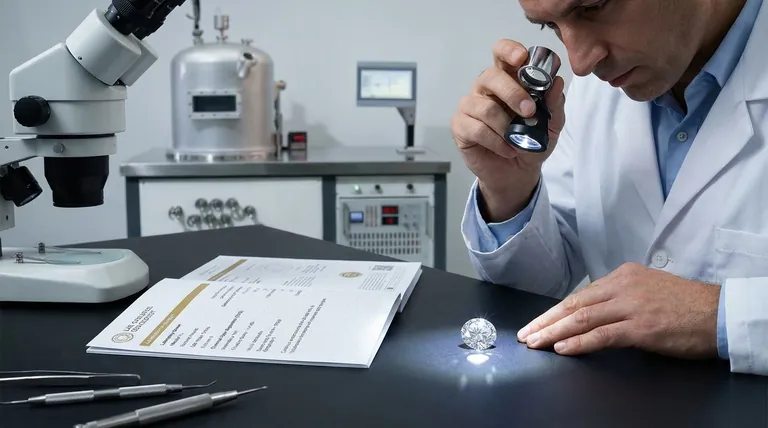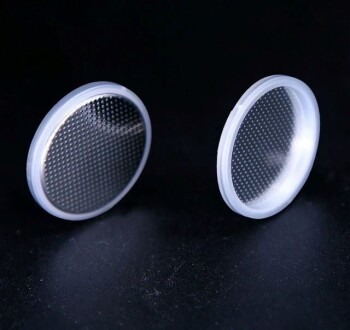Verifying a CVD diamond is most reliably done by examining its official grading report and the corresponding laser inscription on the stone itself. For a consumer or jeweler, these documents from an accredited gemological laboratory are the definitive proof of the diamond's origin, explicitly stating whether it is a laboratory-grown diamond created through the Chemical Vapor Deposition (CVD) process.
The core challenge in identifying a CVD diamond is that it is chemically and physically a real diamond. Therefore, simple "diamond testers" are ineffective. The only definitive verification for a buyer comes from the official documentation and laser inscription provided by a reputable grading lab.
Understanding the Source: What is a CVD Diamond?
To understand how to test for a CVD diamond, you first must understand what it is. Its manufacturing process leaves behind subtle markers that gemological labs can detect.
The CVD Growth Process
Chemical Vapor Deposition (CVD) is a method for growing crystalline diamond in a controlled laboratory environment.
The process begins with a small, thin diamond "seed" placed inside a vacuum chamber. This chamber is then filled with carbon-rich gases (like methane) and heated to extreme temperatures.
These gases break down, and the carbon atoms deposit onto the diamond seed, building up layer by layer and replicating the original diamond's crystal structure.
CVD vs. Natural Diamonds
The resulting CVD product is not a "fake" diamond; it has the same chemical composition and physical properties as a diamond mined from the Earth.
The difference lies entirely in its origin. This distinction is critical for value and disclosure, which is why a separate identification process is necessary.
The Definitive Identification Methods for Buyers
While gemological laboratories use advanced spectroscopic equipment to identify a diamond's origin, a buyer's verification process relies on two key elements that link the physical stone to the lab's findings.
1. The Grading Report (Certificate)
This is the single most important tool for verification. A report from an authentic laboratory like the GIA (Gemological Institute of America) or IGI (International Gemological Institute) will not be ambiguous.
Look for a clear statement in the "Origin" or "Comments" section. It will explicitly identify the stone as "Laboratory-Grown".
The report may also include further detail, such as:
- "This Laboratory Grown Diamond was created by Chemical Vapor Deposition (CVD) growth process..."
- "...and may include post-growth treatment."
- "As Grown – No indication of post-growth treatment."
2. The Laser Inscription
To ensure the diamond you are holding is the same one described in the report, reputable labs laser-inscribe a unique identification number onto the diamond's girdle (its thin outer edge).
This inscription is microscopic and requires a jeweler's loupe to see. It will contain the report number and often includes the words "Laboratory-Grown." You can use this number to look up the digital report on the lab's website for final verification.
Understanding the Trade-offs and Pitfalls
The need for verification stems from significant differences in market value and the importance of transparent disclosure. Failing to verify the source can be a costly mistake.
The Issue of Disclosure
The primary risk is purchasing a lab-grown diamond that is misrepresented—and overpriced—as a natural one. Because they appear identical to the naked eye, a lack of documentation is a major red flag.
The Role of Post-Growth Treatments
As certificates sometimes note, many CVD diamonds undergo post-growth treatments, typically involving high pressure and high temperature (HPHT), to improve their color.
This is a standard, accepted practice, but it must be disclosed on the grading report. An "As Grown" diamond that achieved its high color grade without treatment is often considered more desirable by some buyers.
Limitations of Traditional "Diamond Testers"
Basic handheld testers used by jewelers work by measuring thermal or electrical conductivity. Since CVD diamonds are chemically real diamonds, they will pass these tests. These tools cannot distinguish a lab-grown diamond from a natural one. Relying on them for verification of origin is a critical error.
Making the Right Choice for Your Goal
Your verification strategy depends on ensuring transparency and confirming the identity of the stone you are acquiring.
- If your primary focus is absolute certainty: Always insist on a diamond accompanied by a recent grading report from a top-tier, internationally recognized laboratory.
- If you are verifying a specific stone against its papers: Use a 10x loupe to find the laser inscription on the diamond's girdle and match that report number to the one printed on the certificate and in the lab's online database.
- If you are concerned about authenticity: A diamond with no certificate or one from an unknown lab carries significant risk. The absence of verifiable documentation is a reason for serious caution.
Ultimately, confident identification of a CVD diamond relies on trusting the verifiable, documented findings from an accredited gemological authority.

Summary Table:
| Method | Key Action | Why It's Important |
|---|---|---|
| Grading Report | Check the 'Origin' section for 'Laboratory-Grown' and 'CVD' | Provides definitive, accredited proof of the diamond's source |
| Laser Inscription | Use a loupe to match the girdle inscription to the report number | Confirms the physical stone matches the official documentation |
| Pitfall to Avoid | Do not rely on basic diamond testers | They cannot distinguish between natural and lab-grown diamonds |
Need precise equipment for material analysis or quality control? KINTEK specializes in providing reliable lab equipment and consumables to support your verification and testing processes. Whether you're in gemology, research, or industrial quality assurance, our tools help ensure accuracy and integrity. Contact our experts today to find the right solution for your laboratory's needs.
Visual Guide

Related Products
- HFCVD Machine System Equipment for Drawing Die Nano-Diamond Coating
- Laboratory CVD Boron Doped Diamond Materials
- CVD Diamond Cutting Tool Blanks for Precision Machining
- CVD Diamond Domes for Industrial and Scientific Applications
- Laboratory Test Sieves and Sieving Machines
People Also Ask
- How is diamond coating made? A Guide to CVD and PVD Methods
- What is direct current DC magnetron sputtering? A Guide to High-Quality Thin Film Deposition
- How do CVD diamonds grow? A Step-by-Step Guide to Lab-Grown Diamond Creation
- What is microwave plasma CVD? A Guide to High-Purity Diamond and Material Synthesis
- What is the hot filament chemical vapour deposition of diamond? A Guide to Synthetic Diamond Coating














